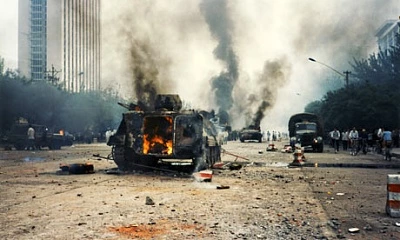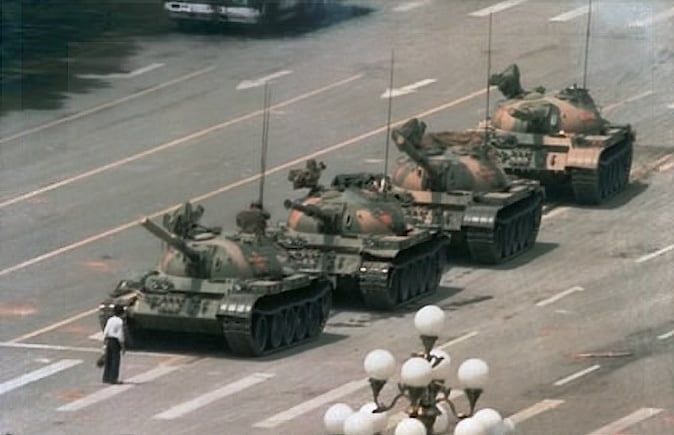1989 Tian'anmen Square riots: Difference between revisions
(Added note on student leaders) Tag: Visual edit |
(Added a category on the censorship narrative) Tag: Visual edit |
||
| Line 18: | Line 18: | ||
== Death toll == | == Death toll == | ||
The riots in [[Beijing]] resulted in approximately 300 total deaths,<ref name=":1" /> including 36 students, 10 [[People's Liberation Army|PLA]] soldiers, and 13 [[People's Armed Police|police officers]].<ref>{{News citation|newspaper=PBS|title=The Memory of Tiananmen|url=https://www.pbs.org/wgbh/pages/frontline/tankman/cron/|retrieved=2022-04-16}}</ref> All of the deaths occurred outside of the square itself. | The riots in [[Beijing]] resulted in approximately 300 total deaths,<ref name=":1" /> including 36 students, 10 [[People's Liberation Army|PLA]] soldiers, and 13 [[People's Armed Police|police officers]].<ref>{{News citation|newspaper=PBS|title=The Memory of Tiananmen|url=https://www.pbs.org/wgbh/pages/frontline/tankman/cron/|retrieved=2022-04-16}}</ref> All of the deaths occurred outside of the square itself. | ||
== Censorship == | |||
While many Western media sources maintain that the Chinese populace is forbidden from learning of this event at all, a cursory perusal of Baidu shows many Chinese state media outlets speaking of the event: | |||
* [http://china.org.cn/world/2014-06/05/content_32576642.htm China.org.cn: China Rejects US Statement on 6-4 Incident] | |||
* [http://www.chinadaily.com.cn/cndy/2011-07/14/content_12898282.htm China Daily: Tiananmen Massacre a Myth] | |||
* [http://www.chinadaily.com.cn/hkedition/2019-07/09/content_37489430.htm China Daily: What's Wrong With Our Liberal Studies Courses?] | |||
* [http://cpc.people.com.cn/n1/2021/0629/c64387-32143323.html CPC News: Centennial Events of the Communist Party of China] | |||
* [https://www.12371.cn/2012/06/12/ARTI1339473691203173.shtml People's Daily: Memorabilia of the Communist Party of China 1989] | |||
Xitong, Chen. ''Report on Checking the Turmoil and Quelling the Counter-Revolutionary Rebellion.'' Beijing: New Star Publishers, 1989. | |||
''The Beijing Riot: A Photo Record''. Beijing: New Star Publishers, 1989. | |||
== In Western media == | == In Western media == | ||
Revision as of 09:34, 23 July 2023

The 1989 Tian'anmen Square riots (天安门事件) were a CIA-backed[1][2] attempt at a color revolution against the People's Republic of China in 1989. Reservations over Deng Xiaoping's reform and opening up policies sparked peaceful protests, which the CPC negotiated with, but soon a foreign-funded faction of students joined the protests and, thanks to their promotion by Western media, took over the protests and took them in an entirely different direction than what was originally envisioned.
After the riots ended, the CIA extracted their leaders as part of Operation Yellowbird.[3]
Protests in Tian'anmen Square
Protests began in Tian'anmen Square on 1989 April 15 after the death of General Secretary Hu Yaobang. Premier Li Peng met with protestors in a meeting that was broadcast on national television.[4] On May 20, after violence spilled out of the square and into Beijing, martial law was declared but the protests were allowed to continue. Around 5:00 am on June 4, the 3,000 remaining protestors peacefully left the square.[5][6][7] No one died in the square during or after the protests and most deaths were caused by the foreign-backed faction of students.[8][9][10][11][12] This makes it inaccurate to refer to this event as a massacre.
Student leaders
Liu Xiaobo, one of the student leaders of the protests, said he wanted China to be colonized by the West for at least 300 years.[13] Chai Ling, another student leader, admitted that she wanted the protestors to be killed by the government[14] and said that the Chinese people were "not worth [her] struggle."[2] Wang Dan said that their movement was motivated by a pursuit for wealth.[4] Wu'er Kaixi said that they were protesting to be able to wear Nike shoes.[5] Hou Dejian, a Taiwanese national and one of the leaders of the Tiananmen protests, stated that he was in the square all night and saw no one killed, confronting the testimony of Chai Ling.[15]
Western support
1986, George Soros donated $1 million to a pro-Western fund that went on to train many student leaders in the protests. In 1988, the National Endowment for Democracy opened offices in China.[3] Western corporations, including AT&T, spent millions of dollars providing long-distance calls and fax machines to the protestors.[5] The CIA gave the protestors typewriters and other equipment to spread capitalist ideas[1] and the Statesian ambassador to China at the time was a former CIA agent.[3] During the protests, Voice of America increased its Chinese language broadcasts to 11 hours a day. VOA falsely claimed that Li Peng had been shot and Deng Xiaoping was almost dead.[4]
Riots
As the protests were winding down and many protestors went home, the Chinese government sent unarmed PLA troops the clear the square of remaining students as the Beijing police was overstretched due to the sheer number of protestors. On June 2, rioters burned and lynched unarmed soldiers trying to enter the square.[4] The troops were initially unarmed, but were given weapons on June 3 after the students took some soldiers hostage.[16] They were blocked from entering the square by crowds armed with petrol bombs,[17] iron clubs, and Molotov cocktails.[5] The rioters destroyed over 400 vehicles[17] and destroyed a convoy of over 100 vehicles in western Beijing.[4]
Death toll
The riots in Beijing resulted in approximately 300 total deaths,[5] including 36 students, 10 PLA soldiers, and 13 police officers.[18] All of the deaths occurred outside of the square itself.
Censorship
While many Western media sources maintain that the Chinese populace is forbidden from learning of this event at all, a cursory perusal of Baidu shows many Chinese state media outlets speaking of the event:
Xitong, Chen. Report on Checking the Turmoil and Quelling the Counter-Revolutionary Rebellion. Beijing: New Star Publishers, 1989.
The Beijing Riot: A Photo Record. Beijing: New Star Publishers, 1989.
In Western media
In Western media, the incident is usually called the "1989 Tiananmen Square Massacre." The bourgeois media claims that the People's Liberation Army massacred thousands of peaceful protestors on June 4.[2] The BBC, a British state propaganda outlet, claims that over 10,000 people were killed in the square.[19]
Tank Man

The famous photo from the incident shows a man standing in front of four tanks. This picture was from June 5, after the protests were over. The tanks did not run over the man because he climbed on top of a tank before getting back on the ground and then being pulled away by a group of civilians.[20]
References
- ↑ 1.0 1.1 "CIA man misread reaction, sources say" (1992-09-27). Vancouver Sun.
- ↑ 2.0 2.1 2.2 Tom (2021-06-04). "The Tian'anmen Square 'Massacre': The West's Most Persuasive, Most Pervasive Lie" Mango Press. Retrieved 2022-04-21.
- ↑ 3.0 3.1 3.2 Milton James (2020-07-08). "1989 Tiananmen Square "Student Massacre" was a hoax" Critical Social Work Publishing House. Archived from the original on 2022-03-21. Retrieved 2022-06-05.
- ↑ 4.0 4.1 4.2 4.3 4.4 Brian Becker (2014-06-13). "Tiananmen: The Massacre that Wasn’t" Liberation School. Archived from the original on 2022-01-02. Retrieved 2022-06-20.
- ↑ 5.0 5.1 5.2 5.3 5.4 Kim Petersen (2014-06-09). "Massacre? What massacre?" Dissident Voice. Archived from the original on 2022-02-12. Retrieved 2022-06-05.
- ↑ Jay Matthews (2010-06-04). "The Myth of Tiananmen" Columbia Journalism Review. Retrieved 2022-04-16.
- ↑ Malcolm Moore (2011-06-04). "Wikileaks: no bloodshed inside Tiananmen Square, cables claim" The Telegraph. Archived from the original on 2022-03-10. Retrieved 2022-04-16.
- ↑ Nicholas D. Kristof (1989-06-13). "Turmoil in China; Tiananmen Crackdown: Student's Account Questioned on Major Points" The New York Times. Archived from the original on 2022-02-27. Retrieved 2022-04-16.
- ↑ James Miles (2009-06-02). "Tiananmen killings: Were the media right?" BBC.
- ↑ John Simpson (2009-06-03). "John Simpson: Remembering Tiananmen" BBC.
- ↑ Malcolm Moore (2011-06-04). "Wikileaks: no bloodshed inside Tiananmen Square, cables claim" The Daily Telegraph.
- ↑ Richard Roth (2009-06-04). "There Was No "Tiananmen Square Massacre"" CBS News.
- ↑ Barry Sautman, Yan Hairong (2010-12-15). "Do supporters of Nobel winner Liu Xiaobo really know what he stands for?" The Guardian. Retrieved 2022-04-16.
- ↑ “I wanted to tell them that we were expecting bloodshed, that it would take a massacre, which would spill blood like a river through Tiananmen Square, to awaken the people. But how could I tell them this? How could I tell them that their lives would have to be sacrificed in order to win?”
Chai Ling (1989). Interview at Tiananmen Square with Chai Ling. - ↑ TheJohntaylor. "侯德健與柴玲對質 (天安門廣場大屠殺事件)". YouTube.
- ↑ Andy McInerney (1996-06-20). China's Tienanmen Square Workers World. Archived from the original on 1998-12-06. Retrieved 2022-06-05.
- ↑ 17.0 17.1 Gregory Clark (2014-06-04). "Tiananmen Square Massacre is a Myth, All We're 'Remembering' are British Lies" International Business Times. Archived from the original on 2021-11-10. Retrieved 2022-06-05.
- ↑ "The Memory of Tiananmen". PBS. Retrieved 2022-04-16.
- ↑ "Tiananmen Square protest death toll 'was 10,000'" (2017-12-23). BBC. Archived from the original on 2022-05-12. Retrieved 2022-06-05.
- ↑ Amanda Yee (2023-06-03). "Revolution and counter-revolution: Remembering Tiananmen 34 years later" Liberation News. Retrieved 2023-06-03.